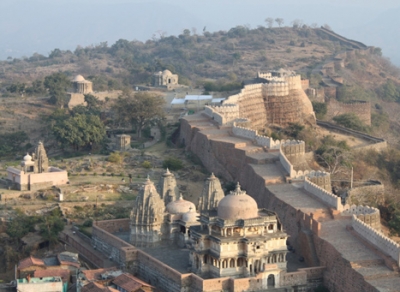
Kumbhalgarh Wall, surrounding the 15th century Kumbhalgarh Fort, is known as The Great Wall of India. Located in the Rajsamand district near Udaipur, and passing through the Aravalli ranges, the wall extends over 36 kms around the perimeter of the fort, making it the second-longest continuous wall in the world after the more well-known Great Wall of China. At its widest sections, the wall is 15 metres thick, with thousands of stone bricks and decorative flourishes along the top. According to folklore, Maharana Kumbha, who built the fort, used to burn massive lamps that consumed 50 kgs of ghee and 100 kgs of cotton to provide light for the farmers who worked during the nights in the valley.
It is believed that the original Kumbhalgarh Fort dates back to the 6th century and was built by King Samprati of the Maurya Age. However, due to the lack of any recorded evidence, the history of the fort from its origins till invasion by Alauddin Khilji in 1303 AD remains vague.
The fort as we see today was built by Kumbhakarna aka Rana Kumbha of Mewar kingdom in the 15th century. It was designed by a famous architect of that period, named Mandan. According to local legends, Rana Kumbha faced many difficulties during the construction of the fort that he nearly abandoned it. Then a holy man told him that all these problems would end if a pure-hearted man willingly sacrificed his life for the construction. On hearing this, the king was disappointed and that was when the holy man beheaded himself and sacrificed his life. After that, the king was able to build the fort without any problems. It is believed that the entrance to the fort marks the place where the holy man’s head fell.
That’s the legend part of it. Historically too, the fort played a major role in shaping the region’s past. Thanks to its strategic location, Kumbhalgarh was used as a safe refuge by the rulers of Mewar at times of threat or danger. It has remained witness to many significant events that have shaped the region’s history like that Maharana Pratap was born in this citadel. The fort provided shelter to the infant Prince Udai of Mewar after Chittor fell under siege. Though the fort came under attack from various rulers and invaders, it remained invincible except for once when, in 1576, it was conquered by Mansingh I, the general of Emperor Akbar. Later, the fort was taken over by the colonial rulers before it finally came under the aegis of the government of Rajasthan.
Picture Credit : Google




